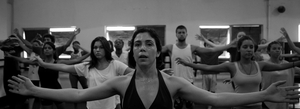Guest Blog: Dr Andrea Maciel On How Dancing Can Aid Mental Health
The therapeutic qualities of movement

The body has memory and its power of communication is stronger than we know. We walk, we run, and as we go by, we probably do a lot of movements that carry a message, even though we might never stop to pay attention to it. When we adopt a practice of surrendering our mental control and letting the body lead the way, there are a bunch of surprising discoveries awaiting.
Dance is one of the most powerful tools in this process of surrendering. It works in a way to nourish our body with the movement it so craves, oiling our joints, stretching our tissues, stimulating our circulation, enlivening our whole being. It often serves beautifully when freeing up emotions to the creativity of our expression, enhancing a letting go of what we might have held onto, welcoming new feelings, opening up new possibilities.
Dance fosters an answering to the present moment when responding to the different qualities of sound, its vibration, energy and rhythm. Listening both to the music and to our movement becomes a joyful interaction between inner and outer perception that can lead to a deeper attunement with our body and its sensitivity.
On a scientific level, it not only gives an immediate sensation of wellbeing as it increases levels of dopamine and stimulates the blood flow awakening our senses, it also works as a 'brain booster', as it improves cerebral health as a whole. A study done in Malaysia a few years ago found that dance can reduce anxiety and depression levels and improve quality of life and cognitive function.
This practice is an axis of connection that allows for a whole and healthy relationship with our bodies throughout life. Especially via those practices that are not only about the aesthetics of how we look.
Dance can provide a close and deep encounter with ourselves. It is a vehicle towards enabling this connection, giving meaning and relevance to our every changing lives and circumstances. And although we do not depend on dance to be well, still we choose to return to its connective axis in order to create a sustainable and collective support that nourishes, allows us to deal with our vulnerabilities and provides the space to flourish.
As part of the Intercultural Roots programme, I have been teaching weekly sessions of Nia: a sensory-based movement practice that merges different types of arts - martial arts, dance and healing. It empowers people of all walks of life to embrace their differences and balance aerobic conditioning and body toning in a fun, engaging, energised way.
Another option offered by the same programme is Qigong Dance. Here I lead alongside Dr. Alex Boyd, adding my movement background to his Taoist Taiji and Qigong practices. Together, we build an alchemy of chi (qi) energy and breath that allows the body to be fully present and to call the awareness to the relationship body-mind-spirit. Alex also teaches a session on Breathwork weekly, via Get Active Online.
Dance is one of the many ways in which we can allow our bodies to be more present and relaxed and, therefore, have a healthier mind. And in a time of digital dispersion and over-stimulation, it is key to make sure to also prioritise the nourishment of our mind, giving it the space it needs in order to rest and dream. People emerge from the Intercultural Roots sessions feeling renewed, healthier, lifted and joyful.
Outside of a set choreography, it is an invitation to allow boredom and repetition to transform into change, flow and exploration, creating new sensations and inner experiences in a playful way. It is a place where nothing is too silly, nothing too outlandish, and every expression is perfect and welcome. Is there a better way of sensing and responding to how the body wants to move, simply following what unfolds and shows up, with no goal to distract from the sheer pleasure such unrestricted movement can give us?
The memory of a body that dances and breathes, that is present and expanded in its consciousness, is a body filled up that becomes imbued with hope instead of anxiety. Its legacy is a path of healing and joy. There is nothing more wonderful than being able to heal oneself and those around us inviting inner freedom through movement.
Comments

Videos

